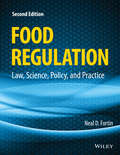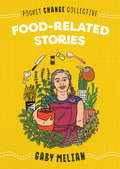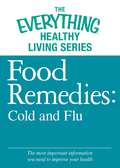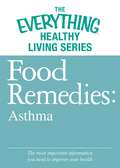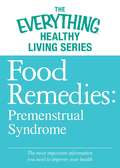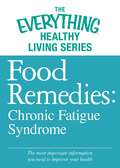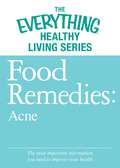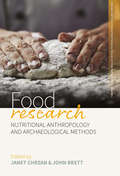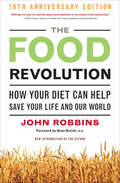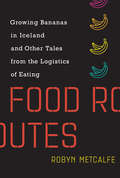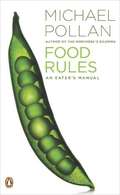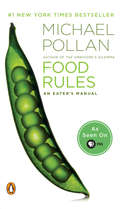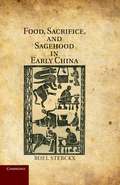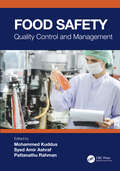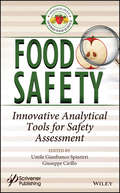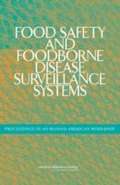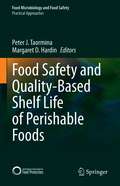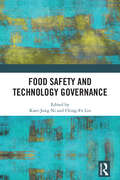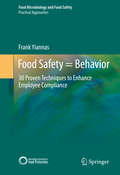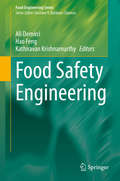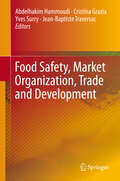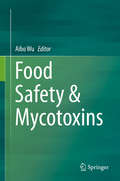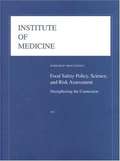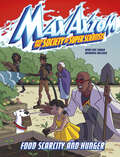- Table View
- List View
Food Regulation: Law, Science, Policy, and Practice
by Neal D. FortinFeaturing case studies and discussion questions, this textbook - with revisions addressing significant changes to US food law - offers accessible coverage appropriate to a wide audience of students and professionals. * Overviews the federal statutes, regulations, and regulatory agencies concerned with food regulation and introduces students to the case law and statutory scheme of food regulation* Focuses updated content on the 2011 FDA Food Safety Modernization Act (FSMA), the biggest change to US food law since the 1930s* Contains over 20% new material, particularly a rewritten import law chapter and revisions related to food safety regulation, health claims, and food defense* Features case studies and discussion questions about application of law, policy questions, and emerging issues
Food-Related Stories (Pocket Change Collective)
by Gaby Melian&“Gaby Melian tells so many stories through her relationship with food—about love, about loss, about hard work, and about finding her passion. The pages are dripping with delicious smells and tastes, and will give you a new way to look at both cooking and what it means to have a plan.&” —Molly Birnbaum, editor in chief, America&’s Test Kitchen KidsIn this moving, personal account, chef and activist Gaby Melian shares her journey with food and how creating a relationship with food -- however simple or complicated -- is a form of activism in its own right.Pocket Change Collective was born out of a need for space. Space to think. Space to connect. Space to be yourself. And this is your invitation to join us. This is a series of small books with big ideas from today's leading activists and artists. "Food rescued me so many other times -- not only because I sold food to survive. I cook to entertain; I cook to be liked; I cook to be loved." In this installment, chef and activist Gaby Melian shares her personal journey with food -- from growing up in Argentina to her time as a Jersey City street vendor and later, as Bon Appetit's test kitchen manager. Powerful and full of heart, here, Melian explores how we can develop a relationship with food that's healthy, sustainable, and thoughtful.
Food Remedies: Cold and Flu (The Everything® Healthy Living Series)
by Adams MediaLooking for an alternative way to treat your cold or flu? The Everything® Healthy Living Series is here to help. These concise, thoughtful guides offer the expert advice and the latest medical information you need to provide healing through eating.Inside you’ll find information on how to treat a cold or flu with food, including recipes for dishes that will get you back on your feet in no time. With this guide, you'll be cooking your way to a clean bill of health.
Food Remedies: Asthma (The Everything® Healthy Living Series)
by Adams MediaLooking for an alternative way to treat your asthma? The Everything® Healthy Living Series is here to help. These concise, thoughtful guides offer the expert advice and the latest medical information you need to provide natural relief for your condition.Inside you’ll find information on how to treat your asthma, including recipes for dishes that will help alleviate symptoms of the condition. With this guide, you'll be cooking your way to a happier, healthier you in no time.
Food Remedies: Pre-Menstrual Syndrome (The Everything® Healthy Living Series)
by Adams MediaLooking for an alternative way to treat your premenstrual syndrome? The Everything® Healthy Living Series is here to help. These concise, thoughtful guides offer the expert advice and the latest medical information you need to provide natural relief for your symptoms.Inside you’ll find information on how to treat your PMS, including recipes for dishes that will help relieve the discomfort associated with it. With this guide, you'll be cooking your way to a happier, healthier you in no time.
Food Remedies: Chronic Fatigue Syndrome (The Everything® Healthy Living Series)
by Adams MediaLooking for an alternative way to treat your chronic fatigue? The Everything® Healthy Living Series is here to help. These concise, thoughtful guides offer the expert advice and the latest medical information you need to provide natural relief for your condition.Inside you’ll find information on how to treat your chronic fatigue, including recipes for dishes that will help correct nutrient deficiencies that may play a role in reducing symptoms of CFS. With this guide, you'll be cooking your way to a happier, healthier you in no time.
Food Remedies: Acne (The Everything® Healthy Living Series)
by Adams MediaLooking for an alternative way to treat your acne? The Everything® Healthy Living Series is here to help. These concise, thoughtful guides offer the expert advice and the latest medical information you need to provide natural relief for your condition.Inside you’ll find information on how to treat your acne, including recipes for dishes that will help promote healthy skin. With this guide, you'll be cooking your way to smoother skin in no time.
Food Research: Nutritional Anthropology and Archaeological Methods (Research Methods for Anthropological Studies of Food and Nutrition #1)
by Janet Chrzan John BrettBiocultural and archaeological research on food, past and present, often relies on very specific, precise, methods for data collection and analysis. These are presented here in a broad-based review. Individual chapters provide opportunities to think through the adoption of methods by reviewing the history of their use along with a discussion of research conducted using those methods. A case study from the author's own work is included in each chapter to illustrate why the methods were adopted in that particular case along with abundant additional resources to further develop and explore those methods.
The Food Revolution: How Your Diet Can Help Save Your Life and Our World
by John RobbinsThe tenth anniversary edition of an essential text on food politics: &“Well researched and lucidly written . . . This book is sure to spark discussion&” (Publishers Weekly). When John Robbins first released The Food Revolution in 1987, his insights into America&’s harmful eating habits gave us a powerful wake-up call. Since then, Robbins has continued to shine a spotlight on the most important issues in food politics, such as our dependence on animal products, provoking awareness and promoting change. Robbins&’s arguments for a plant-based diet are compelling and backed by over twenty years of work in the field of sustainable agriculture and conscious eating. This timely new edition will enlighten those curious about plant-based diets and fortify the mindsets of the already converted.
Food Routes: Growing Bananas in Iceland and Other Tales from the Logistics of Eating
by Robyn MetcalfeFinding opportunities for innovation on the path between farmer and table. Even if we think we know a lot about good and healthy food—even if we buy organic, believe in slow food, and read Eater—we probably don't know much about how food gets to the table. What happens between the farm and the kitchen? Why are all avocados from Mexico? Why does a restaurant in Maine order lamb from New Zealand? In Food Routes, Robyn Metcalfe explores an often-overlooked aspect of the global food system: how food moves from producer to consumer. She finds that the food supply chain is adapting to our increasingly complex demands for both personalization and convenience—but, she says, it won't be an easy ride. Networked, digital tools will improve the food system but will also challenge our relationship to food in anxiety-provoking ways. It might not be easy to transfer our affections from verdant fields of organic tomatoes to high-rise greenhouses tended by robots. And yet, argues Metcalfe—a cautious technology optimist—technological advances offer opportunities for innovations that can get better food to more people in an increasingly urbanized world. Metcalfe follows a slice of New York pizza and a club sandwich through the food supply chain; considers local foods, global foods, and food deserts; investigates the processing, packaging, and storage of food; explores the transportation networks that connect farm to plate; and explains how food can be tracked using sensors and the Internet of Things. Future food may be engineered, networked, and nearly independent of crops grown in fields. New technologies can make the food system more efficient—but at what cost to our traditionally close relationship with food?
Food Rules: An Eater's Manual
by Michael PollanA pocket compendium of food wisdom from the author of The Omnivore's Dilemma and In Defense of Food, Michael Pollan, our nation's most trusted resource for food-related issues, offers this indispensible guide for anyone concerned about health and food.
Food Rules: An Eater's Manual
by Michael Pollan#1 New York Times Bestseller A definitive compendium of food wisdom Eating doesn’t have to be so complicated. <P><P>In this age of ever-more elaborate diets and conflicting health advice, Food Rules brings welcome simplicity to our daily decisions about food. Written with clarity, concision, and wit that has become bestselling author Michael Pollan’s trademark, this indispensable handbook lays out a set of straightforward, memorable rules for eating wisely, one per page, accompanied by a concise explanation. It’s an easy-to-use guide that draws from a variety of traditions, suggesting how different cultures through the ages have arrived at the same enduring wisdom about food. <P>Whether at the supermarket or an all-you-can-eat buffet, this is the perfect guide for anyone who ever wondered, “What should I eat?”
Food, Sacrifice, and Sagehood in Early China
by Roel SterckxIn ancient China, the preparation of food and the offering up of food as a religious sacrifice were intimately connected with models of sagehood and ideas of self-cultivation and morality. Drawing on received and newly excavated written sources, Roel Sterckx's book explores how this vibrant culture influenced the ways in which the early Chinese explained the workings of the human senses, and the role of sensory experience in communicating with the spirit world. The book, which begins with a survey of dietary culture from the Zhou to the Han, offers intriguing insights into the ritual preparation of food - some butchers and cooks were highly regarded and would rise to positions of influence as a result of their culinary skills - and the sacrificial ceremony itself. As a major contribution to the study of early China and to the development of philosophical thought, the book will be essential reading for students of the period, and for anyone interested in ritual and religion in the ancient world.
Food Safety: Quality Control and Management
by Mohammed Kuddus Syed Amir Ashraf Pattanathu RahmanThis book is an updated reference source on food safety best practices. The chapters discuss analytical approaches to measuring food contaminants, quality control and risk assessment of food storage, food irradiation, etc. The contributors discuss how quality control and management help to establish sustainable and secure food systems globally. The book covers topics such as techniques to measure food contaminants, toxins, heavy metals and pesticide content in food.FEATURES Examines the role of food safety approaches in global food supply chains Describes various detection techniques for food contaminants and toxins Discusses the application of nanotechnology and other innovations in food safety and risk assessment Reviews the international regulations for management of food hazards Includes the hazard analysis critical control points (HACCP) principles This book is an essential resource to help students, researchers, and industry professionals understand and address day-to-day problems regarding food contamination and safety and their impact on human health.
Food Safety: Innovative Analytical Tools for Safety Assessment
by Umile Gianfranco Spizzirri Giuseppe CrilloFood safety and quality are key objectives for food scientists and industries all over the world. To achieve this goal, several analytical techniques (based on both destructive detection and nondestructive detection) have been proposed to fit the government regulations. The book aims to cover all the analytical aspects of the food quality and safety assessment. For this purpose, the volume describes the most relevant techniques employed for the determination of the major food components (e.g. protein, polysaccharides, lipds, vitamins, etc.), with peculiar attention to the recent development in the field. Furthermore, the evaluation of the risk associated with food consumption is performed by exploring the recent advances in the detection of the key food contaminants (e.g. biogenic amines, pesticides, toxins, etc.). Chapters tackle such subject as: GMO Analysis Methods in Food Current Analytical Techniques for the Analysis of Food Lipids Analytical Methods for the Analysis of Sweeteners in Food Analytical Methods for Pesticides Detection in Foodstuffs Food and Viral Contamination Application of Biosensors to Food Analysis
Food Safety And Foodborne Disease Surveillance Systems: Proceedings Of An Iranian-american Workshop
by National Research Council of the National AcademiesIn October 2004 the Research Center for Gastroenterology and Liver Diseases of Shaheed Beheshti University hosted in Tehran an Iranian-American workshop on Food Safety and Surveillance Systems for Foodborne Diseases. The purposes of the workshop were to initiate contacts between Iranian and American specialists, exchange information about relevant activities in the two countries, and set the stage for future cooperation in the field. The participants also identified important aspects of food safety that should be addressed more intensively by both countries, including surveillance, research, international trade, and risk assessment. The framework for the workshop had been developed during a meeting of Iranian and American specialists in June 2003 in Les Treilles, France. More that 100 specialists participated in the workshop in their personal capacities, along with representatives of the World Health Organization and the Food and Agriculture Organization. These proceedings include a number of papers that were presented at the workshop together with summaries of discussions following presentation of the papers.
Food Safety and Quality-Based Shelf Life of Perishable Foods (Food Microbiology and Food Safety)
by Peter J. Taormina Margaret D. HardinThis book addresses the shelf life of foods, a key factor in determining how food is distributed and consequently where and when different food products are available for consumption. Shelf life is determined by several factors, including microbiological, chemical, physical, and organoleptic deterioration. Often these factors are interrelated and interdependent. The editors of this volume focus specifically on the microbial factors related to shelf life of perishable foods and food commodities. This allows for more detailed coverage of foodborne bacterial pathogens and spoilage microorganisms of concern. The initial part of the book covers the why and how of shelf life determination as well as the specific microbial pathogens and spoilage microorganisms of concern for perishable foods. Contributors address topics such as the techniques utilized for determination of shelf life, the frequency of shelf life testing for different products, the interpretation of data to make shelf life determinations, and management of shelf life of food products from the perspective of the food producer, distributor, retailer, and regulator. Three key areas impacting shelf life are addressed in detail: sanitation, processing, and packaging. The sanitation chapter explains the necessary components of cleaning and sanitizing to assure a hygienic processing environment and why that is critical to shelf life control. Traditional processing procedures are reviewed and advanced processing technologies are explored. Materials used in food packaging and the utilization of traditional and activated food packaging by product type are covered in detail. The latter two chapters of the book delve into newer techniques of analysis and explore the microbiome of food products. Implications of microbial ecology and microbial quantification in food products are discussed in chapters on genomics and in the changing dogma of meat shelf life. The primary audience for this work includes food industry quality and food safety technicians, managers, directors, and executives responsible for shelf life. Academicians and governmental researchers involved in research and teaching about food safety and quality will also find the material relevant and useful.
Food Safety and Technology Governance
by Kuei-Jung Ni Ching-Fu LinRecent advances in agri-food technology have brought about increasing complexity and emerging challenges to food safety regulation and governance, with many countries greatly divided in their regulatory approaches. As more advanced CRISPR based gene-editing technologies, and novel foods such as cloned animal products, non-traditional plants, nanofood, and plant-based meat are rapidly being developed, debates arise as to whether the existing models of governance require revision to ensure consumer safety. Of equal importance is the extensive use of pesticides, additives, and animal drugs which raise concerns over the methods and approaches of government approval and phasing out of potentially risk-causing chemicals. Heightened public criticism of food safety and technology poses a significant challenge to governments around the world, which struggle to strike a proper balance between technocracy- and democracy-oriented risk governance models. Drawing on expertise from the United States, European Union, Japan, China, Korea, Association of South East Asian Nations, Malaysia, and Taiwan, this book explores existing and emerging issues of food law and policy in the context of technology governance to offer an overarching framework for the interaction between food regulation and technology. It will be essential reading for academics, students and practitioners with an interest in food law and policy, agricultural law and policy and food safety and nutrition studies.
Food Safety = Behavior
by Frank YiannasThis book helps in Achieving food safety success which requires going beyond traditional training, testing, and inspectional approaches to managing risks. It requires a better understanding of the human dimensions of food safety. In the field of food safety today, much is documented about specific microbes, time/temperature processes, post-process contamination, and HACCP-things often called the hard sciences. There is not much published or discussed related to human behavior-often referred to as the "soft stuff. " However, looking at foodborne disease trends over the past few decades and published regulatory out-of-compliance rates of food safety risk factors, it's clear that the soft stuff is still the hard stuff. Despite the fact that thousands of employees have been trained in food safety around the world, millions have been spent globally on food safety research, and countless inspections and tests have been performed at home and abroad, food safety remains a significant public health challenge. Why is that? Because to improve food safety, we must realize that it's more than just food science; it's the behavioral sciences, too. In fact, simply put, food safety equals behavior. This is the fundamental principle of this book. If you are trying to improve the food safety performance of a retail or food service establishment, an organization with thousands of employees, or a local community, what you are really trying to do is change people's behavior. The ability to influence human behavior is well documented in the behavioral and social sciences. However, significant contributions to the scientific literature in the field of food safety are noticeably absent. This book will help advance the science by being the first significant collection of 50 proven behavioral science techniques, and be the first to show how these techniques can be applied to enhance employee compliance with desired food safety behaviors and make food safety the social norm in any organization.
Food Safety Engineering (Food Engineering Series)
by Hao Feng Ali Demirci Kathiravan KrishnamurthyFood Safety Engineering is the first reference work to provide up-to-date coverage of the advanced technologies and strategies for the engineering of safe foods. Researchers, laboratory staff and food industry professionals with an interest in food engineering safety will find a singular source containing all of the needed information required to understand this rapidly advancing topic. The text lays a solid foundation for solving microbial food safety problems, developing advanced thermal and non-thermal technologies, designing food safety preventive control processes and sustainable operation of the food safety preventive control processes. The first section of chapters presents a comprehensive overview of food microbiology from foodborne pathogens to detection methods. The next section focuses on preventative practices, detailing all of the major manufacturing processes assuring the safety of foods including Good Manufacturing Practices (GMP), Hazard Analysis and Critical Control Points (HACCP), Hazard Analysis and Risk-Based Preventive Controls (HARPC), food traceability, and recalls. Further sections provide insights into plant layout and equipment design, and maintenance. Modeling and process design are covered in depth. Conventional and novel preventive controls for food safety include the current and emerging food processing technologies. Further sections focus on such important aspects as aseptic packaging and post-packaging technologies. With its comprehensive scope of up-to-date technologies and manufacturing processes, this is a useful and first-of-its kind text for the next generation food safety engineering professionals.
Food Safety Managing with the HACCP System (Second Edition)
by Ronald F. CichyFood Safety: Managing with the HACCP System, Second Edition, was written to update food safety essentials for food service operations. Just as in the first edition, the second edition emphasizes the essential role the Food Safety Risk Management Program plays in helping each operation reach its quality, cost control, and food safety goals. Using the HACCP system allows managers, owners, and staff members to more easily integrate the property's safety, quality, and cost control systems.
Food Safety, Market Organization, Trade and Development
by Abdelhakim Hammoudi Cristina Grazia Yves Surry Jean-Baptiste TraversacThis book provides an economic perspective on the effects of food safety standards on international trade. Focusing on food safety regulation at an international level and private food safety standards, the authors use contemporary methodologies to analyze supply chain structures and organization as well as food-chain actors' strategies. They also evaluate the effects of these on both consumer health and developing countries' access to international markets. The book provides ideas, suggestions and policy recommendations for reconciling economic interests with consumer health, which will be of special interest to academics as well as to practitioners.
Food Safety & Mycotoxins
by Aibo WuMycotoxins are increasingly attracting attention at thegovernmental, public and academic level worldwide, due to more frequent and serious contaminations of food and feedstuffs, which pose a serious threat to human health and animal production. This book reviews the latest research on mycotoxins that directly concern food safety, and especially focuses on detection technologies, risk assessment and control strategiescurrently being used in China. Gathering contributions from over 20 respected researchers, the book will benefit graduatestudents, researchers and management groups from various disciplines, including food science and technology, analytical chemistry, plant pathology, public health, etc.
Food Safety Policy, Science, and Risk Assessment: Workshop Proceedings
by Food ForumThe National Academies Press (NAP)--publisher for the National Academies--publishes more than 200 books a year offering the most authoritative views, definitive information, and groundbreaking recommendations on a wide range of topics in science, engineering, and health. Our books are unique in that they are authored by the nation's leading experts in every scientific field.
Food Scarcity and Hunger: A Max Axiom Super Scientist Adventure (Max Axiom and the Society of Super Scientists)
by Myra Faye TurnerEvery year, the world’s farmers produce a lot of food for people to eat. Yet every night, millions of people around the world go to bed hungry. Why are people going without food when the earth is able to produce so much? In this nonfiction graphic novel, Max Axiom and the Society of Super Scientists go on a fact-finding mission to discover the reasons behind food scarcity. Young readers can join the team to find out why many people deal with food insecurity and learn ways that they can help.
